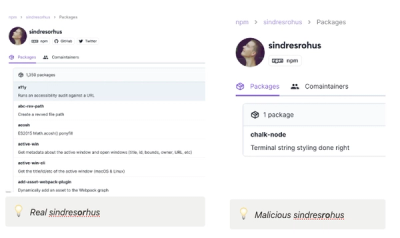
Security News
JSR Working Group Kicks Off with Ambitious Roadmap and Plans for Open Governance
At its inaugural meeting, the JSR Working Group outlined plans for an open governance model and a roadmap to enhance JavaScript package management.
remark-parse
Advanced tools
The remark-parse package is a plugin for the Remark processor that parses Markdown content into a syntax tree. It is part of the unified ecosystem, which provides a way to parse, transform, and stringify content using abstract syntax trees (ASTs).
Parsing Markdown
This feature allows you to parse Markdown content and transform it into an abstract syntax tree (AST). The code sample demonstrates how to use remark-parse with the remark library to parse a simple Markdown string.
const remark = require('remark');
const parse = require('remark-parse');
remark().use(parse).process('# Hello world!', function(err, file) {
if (err) throw err;
console.log(file);
});Extensible Markdown Parsing
remark-parse can be extended with plugins to handle custom Markdown syntax. In this example, the 'remark-math' plugin is used to parse mathematical expressions within the Markdown content.
const remark = require('remark');
const parse = require('remark-parse');
const math = require('remark-math');
remark().use(parse).use(math).process('Euler's identity: $e^{i\pi} + 1 = 0$', function(err, file) {
if (err) throw err;
console.log(file);
});markdown-it is a Markdown parser with a similar goal to remark-parse, but it is implemented differently. It is often used for its speed and extensibility with plugins, and it can output HTML directly instead of an AST.
marked is another Markdown parser that is known for being fast and lightweight. It is less extensible than remark-parse but can be a good choice for simpler use cases where a full AST is not required.



Parser for unified. Parses markdown to an mdast syntax tree. Used in the remark processor. Can be extended to change how markdown is parsed.
npm:
npm install remark-parse
var unified = require('unified');
var markdown = require('remark-parse');
var html = require('remark-html');
process.stdin
.pipe(unified())
.use(markdown)
.use(html)
.pipe(process.stdout, {
'commonmark': true
});
processor.use(parse)Configure the processor to read markdown as input and process an
mdast syntax tree.
optionsOptions are passed later through processor.parse(),
processor.process(), or processor.pipe().
The following settings are supported:
gfm (boolean, default: true);yaml (boolean, default: true);commonmark (boolean, default: false);footnotes (boolean, default: false);pedantic (boolean, default: false);breaks (boolean, default: false).options.gfmhello ~~hi~~ world
GFM mode (default: true) turns on:
options.yaml---
title: YAML is Cool
---
# YAML is Cool
YAML mode (default: true) enables raw YAML front matter to be detected
at the top.
options.commonmarkThis is a paragraph
and this is also part of the preceding paragraph.
CommonMark mode (default: false) allows:
( and )) around for link and image titles;)) as an ordered list marker;CommonMark mode disallows:
# Hash headings) without spacing after opening hashes
or and before closing hashes;Underline headings\n---) when following a paragraph;< and >);>), for lists, code, and thematicBreak.options.footnotesSomething something[^or something?].
And something else[^1].
[^1]: This reference footnote contains a paragraph...
* ...and a list
Footnotes mode (default: false) enables reference footnotes and inline
footnotes. Both are wrapped in square brackets and preceded by a caret
(^), and can be referenced from inside other footnotes.
options.breaksThis is a
paragraph.
Breaks mode (default: false) exposes newline characters inside
paragraphs as breaks.
options.pedanticCheck out some_file_name.txt
Pedantic mode (default: false) turns on:
_alpha_) and importance (__bravo__) with underscores
in words;*, -, +);commonmark is also turned on, ordered lists with different
markers (., ));parse.ParserAccess to the parser, if you need it.
Most often, using transformers to manipulate a syntax tree produces the desired output. Sometimes, mainly when introducing new syntactic entities with a certain level of precedence, interfacing with the parser is necessary.
If this plug-in is used, it adds a Parser constructor to
the processor. Other plug-ins can add tokenizers to the parser’s
prototype to change how markdown is parsed.
The below plug-in adds a tokenizer for at-mentions.
function mentions(processor) {
var Parser = processor.Parser;
var tokenizers = Parser.prototype.inlineTokenizers;
var methods = Parser.prototype.inlineMethods;
/* Add an inline tokenizer (defined in the following example). */
tokenizers.mention = tokenizeMention;
/* Run it just before `text`. */
methods.splice(methods.indexOf('text'), 0, 'mention');
}
module.exports = mentions;
Parser#blockTokenizersAn object mapping tokenizer names to tokenizers. These
tokenizers (for example: fencedCode, table, and paragraph) eat
from the start of a value to a line ending.
Parser#blockMethodsArray of blockTokenizers names (string) specifying the order in
which they run.
Parser#inlineTokenizersAn object mapping tokenizer names to tokenizers. These tokenizers
(for example: url, reference, and emphasis) eat from the start
of a value. To increase performance, they depend on locators.
Parser#inlineMethodsArray of inlineTokenizers names (string) specifying the order in
which they run.
function tokenizer(eat, value, silent)function tokenizeMention(eat, value, silent) {
var match = /^@(\w+)/.exec(value);
if (match) {
if (silent) {
return true;
}
return eat(match[0])({
'type': 'link',
'url': 'https://social-network/' + match[1],
'children': [{
'type': 'text',
'value': match[0]
}]
});
}
}
tokenizeMention.notInLink = true;
tokenizeMention.locator = locateMention;
The parser knows two types of tokenizers: block level and inline level. Block level tokenizers are the same as inline level tokenizers, with the exception that the latter must have a locator.
Tokenizers test whether a document starts with a certain syntactic entity. In silent mode, they return whether that test passes. In normal mode, they consume that token, a process which is called “eating”. Locators enable tokenizers to function faster by providing information on where the next entity may occur.
Node? = tokenizer(eat, value);boolean? = tokenizer(eat, value, silent).eat (Function) — Eat, when applicable, an entity;value (string) — Value which may start an entity;silent (boolean, optional) — Whether to detect or consume.locator (Function)
— Required for inline tokenizers;onlyAtStart (boolean)
— Whether nodes can only be found at the beginning of the document;notInBlock (boolean)
— Whether nodes cannot be in blockquotes, lists, or footnote
definitions;notInLink (boolean)
— Whether nodes cannot be in lists.notInLink (boolean)
— Whether nodes cannot be in links.value;value.tokenizer.locator(value, fromIndex)function locateMention(value, fromIndex) {
return value.indexOf('@', fromIndex);
}
Locators are required for inline tokenization to keep the process performant. Locators enable inline tokenizers to function faster by providing information on the where the next entity occurs. Locators may be wrong, it’s OK if there actually isn’t a node to be found at the index they return, but they must skip any nodes.
value (string) — Value which may contain an entity;fromIndex (number) — Position to start searching at.Index at which an entity may start, and -1 otherwise.
eat(subvalue)var add = eat('foo');
Eat subvalue, which is a string at the start of the
tokenized value (it’s tracked to ensure the correct
value is eaten).
subvalue (string) - Value to eat.add.
add(node[, parent])var add = eat('foo');
add({type: 'text', value: 'foo'});
Add positional information to node and add it to parent.
node (Node) - Node to patch position on and insert;parent (Node, optional) - Place to add node to in
the syntax tree. Defaults to the currently processed node.The given node.
add.test()Get the positional information which would be patched on
node by add.
add.reset(node[, parent])add, but resets the internal location. Useful for example in
lists, where the same content is first eaten for a list, and later
for list items
node (Node) - Node to patch position on and insert;parent (Node, optional) - Place to add node to in
the syntax tree. Defaults to the currently processed node.The given node.
FAQs
remark plugin to add support for parsing markdown input
The npm package remark-parse receives a total of 7,607,662 weekly downloads. As such, remark-parse popularity was classified as popular.
We found that remark-parse demonstrated a not healthy version release cadence and project activity because the last version was released a year ago. It has 2 open source maintainers collaborating on the project.
Did you know?

Socket for GitHub automatically highlights issues in each pull request and monitors the health of all your open source dependencies. Discover the contents of your packages and block harmful activity before you install or update your dependencies.

Security News
At its inaugural meeting, the JSR Working Group outlined plans for an open governance model and a roadmap to enhance JavaScript package management.

Security News
Research
An advanced npm supply chain attack is leveraging Ethereum smart contracts for decentralized, persistent malware control, evading traditional defenses.

Security News
Research
Attackers are impersonating Sindre Sorhus on npm with a fake 'chalk-node' package containing a malicious backdoor to compromise developers' projects.